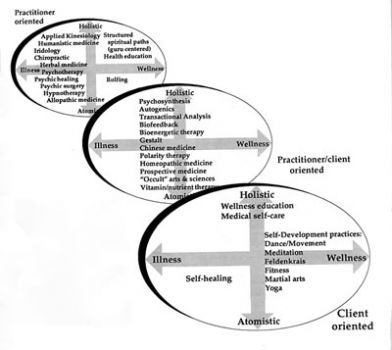Populating the 3-D Model
By placing activities/disciplines in this three-dimensional display, as we did in on the two-dimensional grid a few pages back, we can see relationships not otherwise taken into account. To compensate for the difficulty of showing three dimensions in a two-dimensional medium, we will use the rear oval to represent disciplines at the practitioner-oriented end of the Practitioner-/Client-Oriented Continuum. The middle oval represents the mid-point on that contiuume, with the foreground representing the most client-oriented activities/disciplines.

Placement of Some Activities/Disciplines in the 3-D Model
There is a large degree of variation in the location where some of these activities/disciplines could be placed, depending on the attitudes of the practitioner and clients engaged in them. We use it for illustrative purposes* and invite you to add more of your own or move any that we have placed according to your experience of them. (continues)
* It is tempting to make value judgments about some of these scales. We've arranged the model so that the prevailing illness care practices fall in the lower left quadrant of the rear oval. This is not done to invalidate them. We arranged the axes to represent our definitions of wellness in the most prominent quadrant because these definitions are unfamiliar to many people. All of these activities/practices are valid, and important, and meet different needs. Problems often arise because too much is expected of one discipline, e.g., if you break a bone, it is appropriate for you to find a person who can set the fracture - then you may want to look at the underlying issues which may have factored in breaking the bone.


